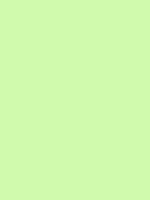#d0faad Color Information
In a RGB color space, hex #d0faad is composed of 81.6% red, 98% green and 67.8% blue. Whereas in a CMYK color space, it is composed of 16.8% cyan, 0% magenta, 30.8% yellow and 2% black. It has a hue angle of 92.7 degrees, a saturation of 88.5% and a lightness of 82.9%. #d0faad color hex could be obtained by blending #ffffff with #a1f55b. Closest websafe color is: #ccff99.
-
- R 82
- G 98
- B 68
-
- C 17
- M 0
- Y 31
- K 2
● #d0faad color description : Very soft green.
#d0faad Color Conversion
The hexadecimal color #d0faad has RGB values of R:208, G:250, B:173 and CMYK values of C:0.17, M:0, Y:0.31, K:0.02. Its decimal value is 13695661.
| Hex triplet | d0faad | #d0faad |
|---|---|---|
| RGB Decimal | 208, 250, 173 | rgb(208,250,173) |
| RGB Percent | 81.6, 98, 67.8 | rgb(81.6%,98%,67.8%) |
| CMYK | 17, 0, 31, 2 | |
| HSL | 92.7°, 88.5, 82.9 | hsl(92.7,88.5%,82.9%) |
| HSV (or HSB) | 92.7°, 30.8, 98 | |
| Web Safe | ccff99 | #ccff99 |
| CIE-LAB | 93.796, -26.639, 32.64 |
|---|---|
| XYZ | 67.739, 84.797, 52.332 |
| xyY | 0.331, 0.414, 84.797 |
| CIE-LCH | 93.796, 42.131, 129.219 |
| CIE-LUV | 93.796, -20.489, 50.69 |
| Hunter-Lab | 92.085, -29.843, 30.766 |
| Binary | 11010000, 11111010, 10101101 |
Color Schemes with #d0faad
Alternatives to #d0faad
Below, you can see some colors close to #d0faad. Having a set of related colors can be useful if you need an inspirational alternative to your original color choice.
#d0faad Preview
This text has a font color of #d0faad.
<span style="color:#d0faad;">Text here</span>This paragraph has a background color of #d0faad.
<p style="background-color:#d0faad;">Content here</p>This element has a border color of #d0faad.
<div style="border:1px solid #d0faad;">Content here</div>.text {color:#d0faad;}.background {background-color:#d0faad;}.border {border:1px solid #d0faad;}Shades and Tints of #d0faad
A shade is achieved by adding black to any pure hue, while a tint is created by mixing white to any pure color. In this example, #050a01 is the darkest color, while #fafff7 is the lightest one.
-
#050a01
#050a01rgb(5,10,1) -
#0e1d02
#0e1d02rgb(14,29,2) -
#172f03
#172f03rgb(23,47,3) -
#204204
#204204rgb(32,66,4) -
#295405
#295405rgb(41,84,5) -
#326706
#326706rgb(50,103,6) -
#3b7907
#3b7907rgb(59,121,7) -
#448c09
#448c09rgb(68,140,9) -
#4d9e0a
#4d9e0argb(77,158,10) -
#56b10b
#56b10brgb(86,177,11) -
#5fc30c
#5fc30crgb(95,195,12) -
#68d60d
#68d60drgb(104,214,13) -
#71e80e
#71e80ergb(113,232,14)
-
#7bf119
#7bf119rgb(123,241,25) -
#86f22c
#86f22crgb(134,242,44) -
#90f33e
#90f33ergb(144,243,62) -
#9bf451
#9bf451rgb(155,244,81) -
#a6f563
#a6f563rgb(166,245,99) -
#b0f776
#b0f776rgb(176,247,118) -
#bbf888
#bbf888rgb(187,248,136) -
#c5f99b
#c5f99brgb(197,249,155) -
#d0faad
#d0faadrgb(208,250,173) -
#dbfbbf
#dbfbbfrgb(219,251,191) -
#e5fcd2
#e5fcd2rgb(229,252,210) -
#f0fde4
#f0fde4rgb(240,253,228) -
#fafff7
#fafff7rgb(250,255,247)
Tones of #d0faad
A tone is produced by adding gray to any pure hue. In this case, #d3d5d2 is the less saturated color, while #d0fdaa is the most saturated one.
-
#d3d5d2
#d3d5d2rgb(211,213,210) -
#d3d9ce
#d3d9cergb(211,217,206) -
#d3dccb
#d3dccbrgb(211,220,203) -
#d2dfc8
#d2dfc8rgb(210,223,200) -
#d2e3c4
#d2e3c4rgb(210,227,196) -
#d2e6c1
#d2e6c1rgb(210,230,193) -
#d2e9be
#d2e9bergb(210,233,190) -
#d1edba
#d1edbargb(209,237,186) -
#d1f0b7
#d1f0b7rgb(209,240,183) -
#d1f3b4
#d1f3b4rgb(209,243,180) -
#d0f7b0
#d0f7b0rgb(208,247,176) -
#d0faad
#d0faadrgb(208,250,173) -
#d0fdaa
#d0fdaargb(208,253,170)
Color Blindness Simulator
Below, you can see how #d0faad is perceived by people affected by a color vision deficiency. This can be useful if you need to ensure your color combinations are accessible to color-blind users.
